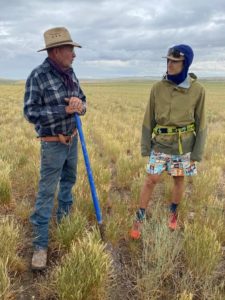
Mounds of a low-growing, spike-leafed grass form a mat in front of prairie dog holes on a ranch just north of Billings. The grass is not native, the prairie dogs are considered pests by many ranchers. Steve Charter embraces them both on his land. They are, he tells us, part of the system.
After decades of ranching these semi-arid lands, Charter knows better than to assume he completely understands the ecosystem. His goal is to help heal the lands impacted by years of well-intended, but damaging grazing and planting decisions. He’s willing to accept that prairie dogs and the right plants from faraway places may have a role to play in that.
Ecosystems, like other complex systems, go through cycles of collapse and reorganization. They grow, then become specialized and more efficient, but less resilient. Their complexity reinforces the relationships between specific parts and they become more fragile, likely to fail. The forage kochia from Eurasia and pesky native rodents are a dynamic part of Steve’s efforts to create richer soil and increase the biodiversity, complexity, and resiliency of the ecosystem of his ranch.
On Day 5 of WRFI’s 2021 Cycle the Rockies summer course, we awoke packed together in what Steve calls ‘Man Camp,’ a stilted old trailer. We wouldn’t ride today, and walked out in shorts into the sweet smell of sage. The shrubs and grasses, wet from welcome rain, scraped my bare shins.
After breakfast we took a slow walk with Steve. Every few yards Steve stopped us to point out a well-decomposed cow patty (thank you dung beetles), or cheatgrass (an unwelcome noxious weed), or a healthy yucca (in full bloom.) Sometimes he simply kicked up some soil and gave us a smile. Watching Steve walk around his ranch with his reassuring smile, almost imperceptible at times, I couldn’t help but smile myself. This was a man who has found what makes him happy.
The first rain drops began to fall on my bare notebook as we crested a bluff above the prairie dog colony. It stood out as a bare patch of dirt punctuated by mounds. The spikey grass seemed more prolific near the holes, with signs that it had been mowed by prairie dogs trying to clear a sightline to would-be predators.
Charter planted the forage kochia hoping that it would grow well and cover bare ground. “No bare ground” is a fundamental principle of Charter’s efforts to cultivate soil organic matter. After he planted the forage kochia, it disappeared and he felt it was a failed experiment. Then he saw it was cropping up around prairie dog holes. Apparently they were somehow bringing the seeds close to their holes, where the plant grew.
Where most see pests, Steve saw opportunity. Why not let the prairie dogs help create a layer of biomass that enriches the soil? Cows love to graze it, too, he said. Where some see problematic parts of the ecosystem, he sees the whole. He thinks in systems.
The complexity of the systems that make up the community of plants at the Charter ranch is difficult to appreciate. The energy from the sun makes its way through the leaves of the plants designed to transform it into sugar. A symbiotic fungus answers the plants’ needs for nutrients, bringing a metaphorical grocery bag of nitrogen, phosphorus and carbon to the roots in just the right measure.
Till-based agriculture destroys this fungus. Traditional agriculture responds by providing chemical fertilizer in lieu of the deliveries the tilled fungus would have made. Humans take over for the tasks nature had in hand. The system, as we understand it, becomes less complicated, less resilient, less circular. Arrogantly, we think we can do from the top what the fungi do in the soil. We assume that we understand the systems that underpin crop growth so well that we can optimize it.
I left the group and jogged toward the ranch house. The sage grabbed at my shorts and grasses soaked my shoes. I stepped into Steve’s house and for a precious moment let the warmth engulf me. Taking socks off never felt so good.
Much of what is problematic with our current agricultural system is that humans assume we understand it well enough to optimize it.
Any systems theorist would warn that such interference in the absence of a complete understanding of a system is likely to increase specialization and accelerate the point at which a system collapses. The Montana prairie is no different. It is a poorly understood complex system. Interference is likely to accelerate the road to collapse.
Steve believes feeding 8 billion people is not entirely up to science but must work in tandem with spirituality, bordering on the supernatural. Where do the solutions lie? We don’t know, but to rule out anything beyond contemporary agriculture is foolish, Steve said.
Steve’s mud room fills with sweaty, unwashed and newly soaked WRFI students. The shelves become host to dirty and soaking wet socks and the magic of what we just experienced begins to sink in. Perhaps the answers to more sustainable ranching lie in whatever is making our socks smell like that…or perhaps not.
Dominic Corradino is a student at Montana State University, where he is majoring in Liberal Studies and Environmental Studies. He is originally from Boulder, Colorado.